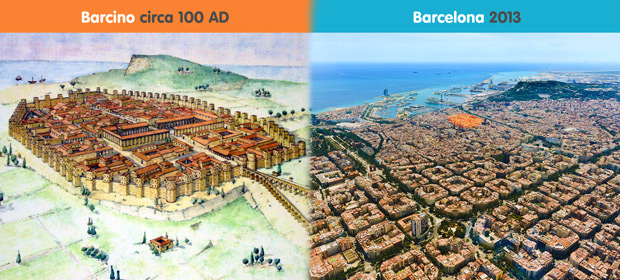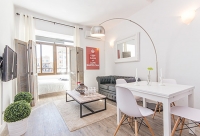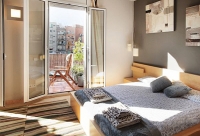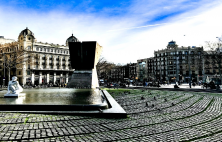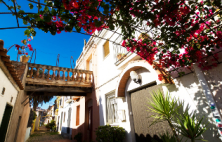Archeological evidence suggests activity around Barcelona goes back almost 4000 - 5500 years. It's hard to say what was going on that far back, but we can be pretty sure that a population called the Laietani resided on the hills and at the foot of Montjuïc around 3 – 2 BC. Coins have been found with an ancient Iberian language that shows the population living here called the area Bàrkeno (script shown in the image below), which means "The Place of the Plains" (Barrke = plains/terrace). It's widely said that the Carthaginians would come and set up a military base here as part of their Spanish conquests under Hamilcar Barca. One founding story states Hamilcar came up with the name Barkeno, yet the coinage found and etymology of the word Barkeno contradicts this and the idea has never been confirmed. The Carthaginians were certainly active all over the Iberian peninsular, but that level of influence in this particular area is undetermined.
Apartments in Gothic Quarter
If you come to visit Barcelona, we advise you to stay in an apartment in a Gothic Quarter. This way, you will know one of the most emblematic districts of Barcelona and save money since hotels are more expensive and offer you less space and comfort.

Eventually the Romans arrived to conquer the Carthaginians from the peninsula, taking it almost in its entirety, including the area we know as Barcelona. They settled a small area on a hill called Mont Tàber of 25m in height. Caesar Augustus came to Iberia to monitor the region and by 14 AD he officially cemented the Roman presence in this area. Caesar then changed the official name from Colonia Faventia Julia Augusta Pia Barcino, to simply; Barcino. It served as a settlement location for retired soldiers in the form of a castrum and at its start there likely would have been only around 50-100 inhabitants. One thing is for sure; there wasn't much in the way of trade as Caesar simply didn't see the potential. By 2BC, it would inhabit roughly 5000 citizens.
That's right, the land on which Barcino was settled was of little value to the Romans in terms of commerce, but it was set up nevertheless, ensuring the security of trade with the Iberian portion of the Roman empire and helping to protect the more prosperous and neighbouring city of Tarragona (or Tarraco) which was the capital of the area.

Excursions in Barcelona
Enjoy Barcelona to the full and fill your trip with unforgettable experiences and emotions reserving an excursion in the Catalan capital organized by the GetYourGuide team. Thanks to the local guides you will discover the pure life of the city and feel the soul of Barcelona! Choose your excursion and fall in love with Barcelona:
The City that Caesar Underestimated
When the idea of settling Barcino was conceived in the mind of Caesar Augustus, one thing he probably didn't count on was that this city would one day become the second largest in Spain and eventually overtake Rome itself, the capital of the Roman empire, in both economic and cultural aspects. After being well established on the Iberian peninsula though, the Romans began to see its potential. Thanks to the commercial development of the city, it earned immunity from taxation.
One curious thing about Barcino, was that although it was still a small city one century later, a large temple dedicated to Caesar was constructed (over 600 sq m), which you can still visit the remains of today by touring the Gothic Quarter. By now the city was very rich yet the temple was the only public building in the city… not a theatre or an arena in sight.
By 250 AD, it was clear that the city was already the most important in the area, with many attacks in the area from the Visigoths, it was Barcino that received the best fortifications known at the time, better than that of Tarraco. So strong were these fortifications that you can still see the remains of these walls today along with lots of other remnants of the original city.
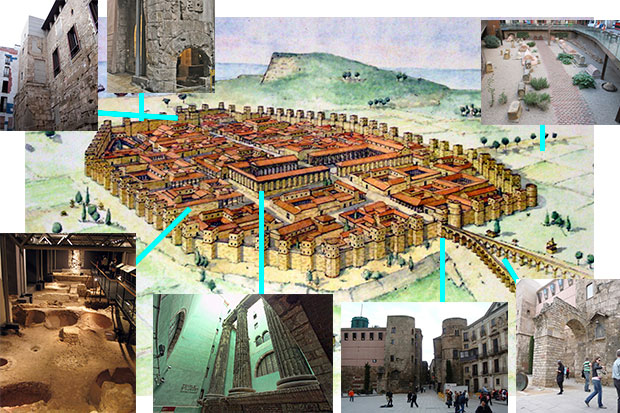
Top: City Wall/Defense tower, City Entrance, Necropolis.
Bottom: Roman Workshops, Temple of Augustus, North Entrance, Aqueduct.
If you have the urge to discover Roman Barcino for yourself then you can do just that using our street guide through Roman history in Barcelona.
Barcino becomes Barchinona which becomes Barshiluna
The next few centuries are riddled with persecution of Christians and eventually acceptance, which prompted the construction of a temple that the current Barcelona Cathedral was built upon. By the 5th century, the Visigoths were granted control of the city in an alliance deal after years of wars. Under the Visigoth/Latin rule, jews were persecuted heavily.
Muslims took control in the 8th century but their reign didn't last very long at all. The biggest changes were that they turned the temple at the time into a mosque. Apart from taxes on non-muslims, there was freedom of religion and the muslim government was widely respected. The city has expanded a lot and will continue to expand to what is eventually known as "Ciutat Vella" or the old city, by the medieval era.
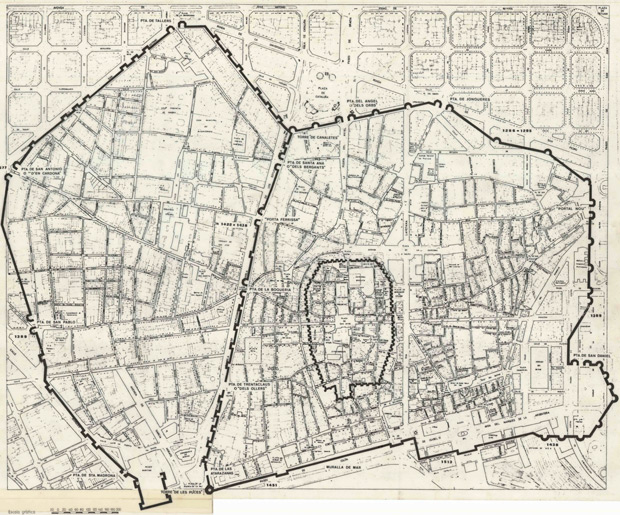
Medieval Barcelona compared to Barcino in the centre.
Welcome to Barcelona!
With the rise of another Emperor, Barshiluna was eventually taken under orders of Charlemagne as part of the Spanish March. This led to a change in name and the first Count of Barcelona, which in turn lead to the territory and surrounding areas becoming it's own principality, which makes up most of the region of Catalonia we know today.
The Ultimate Expansion
Much happened in these years politically and historically, but the city never really expanded heavily. In the 19th century the population was growing rapidly and something had to be done, so the idea of "Eixample" or "Expansion" was proposed. This is the biggest transformation, and has made Barcelona into the city we know today; a major international city that attracts millions of visitors from all around the world, with lots of fantastic modernist architecture.
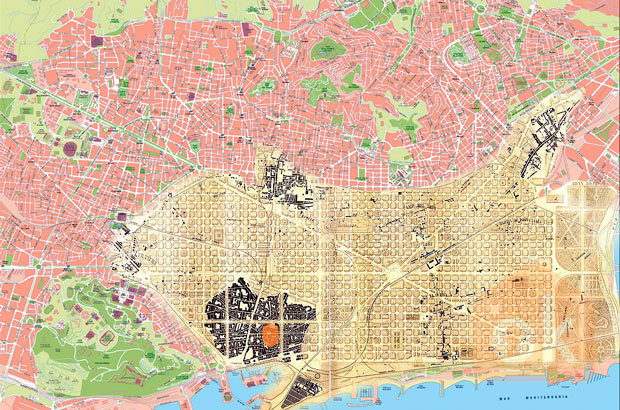
Map showing Barcino (orange), the old city (black), the planned expansion at the time (beige) and Barcelona today (red).

